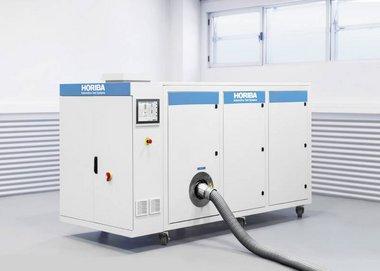Therefore, the upcoming Worldwide Harmonized Light-Duty Test Procedure (WLTP) will include altitude and cold tests in the homologation process to regulate emissions and replicate actual driving conditions more precisely. Many attempts have been made by OEMs to analyze the effect of altitude on engine performance and emissions using computer simulations, RDE and altitude test benches. HORIBA constantly puts a lot of effort into research and development of new products in order to support its customers and to meet the highest possible standards in terms of accuracy and reliability. In cooperation with the Polytechnic University of Valencia (Universitat Politècnica de València, UPV), HORIBA developed MEDAS (Mobile Efficient Dynamic Altitude Simulator), an innovative altitude simulation system for performance and emission optimization in engine development intended for flexible use. It was successfully launched at this year’s Automotive Testing Expo Europe.
Testing on a high level
The altitude of the engine affects several of its variables: a lower atmospheric pressure for example reduces the air density, which in turn affects engine performance and emissions. Also, the start of combustion is delayed in correlation with the altitude, increasing the maximum in-cylinder pressure along with mechanical loads acting on the cylinder walls.
“The mapping of real driving situations in the test bench is gaining importance for manufacturers worldwide,” says Dr. Stefan Bender, General Manager Automotive Test Systems, HORIBA Europe GmbH. “With MEDAS, we offer our customers an advanced solution for research and development for engine optimization that realizes rapid, cost-efficient test procedures with increased measurement reliability.”
MEDAS is able to achieve the necessary engine intake and exhaust pressure levels to reproduce altitude conditions. It simulates vacuum as well as overpressure and recreates altitudes between sea level and up to 5000 meters. These values cover the altitude test requirements of most applications for passenger cars to a medium range of vans. The adjustable temperature depends on the current operation mode “vacuum” or “overpressure” and can be reduced up to 30 ºC below ambient temperature maximally without any additional chilled media supply.
Fulfilment of legal regulations
After characterization tests, HORIBA and UPV analyzed a Diesel engine’s performance and emissions at different altitudes during different driving cycles like NEDC and WLTC (Worldwide Harmonized Light-Duty Test Cycle) by using MEDAS. Here, the altitude simulator demonstrates its ability to provide accurate pressure and temperature conditions in a wide range of reproduced altitudes. The results show that there is a need for new engine control strategies to comply with legal restrictions under different altitudes. For this very reason, it is important to be able to supply useful testing tools for low-pressure and low-temperature operating conditions such as MEDAS.
